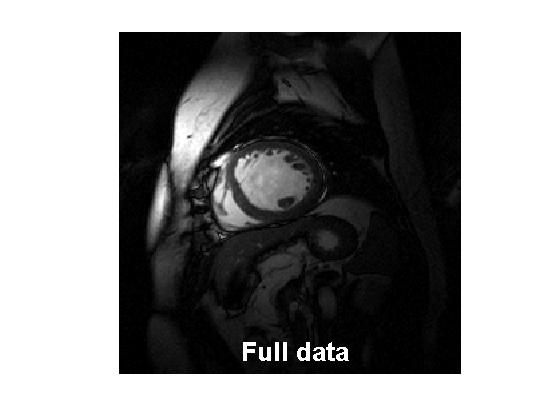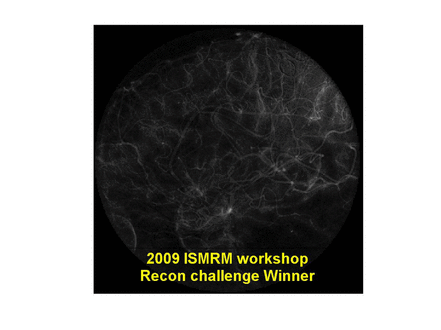|
|
k-t FOCUSS We developed k-t FOCUSS algorithm which is optimal from compressed sensing point of view. The basic concept of k-t FOCUSS starts from compressed sensing theory. According to compressed sensing theory, it is possible to reconstruct original signal from severely reduced sampling ratio which break Nyquist sampling limit. Therefore, this theory is getting huge interests in MRI area, because it is greatly required to reconstruct artifact free images from very sparse measurements to improve temporal resolution. There are some constraints to exploit this concept. From compressed sensing perspective, the aliasing pattern due to down sampling should incoherently appear. Therefore, the random sampling pattern is preferred. Furthermore, the original signal should be able to be sparsely transformed or compressed. And then, L1 minimization of the sparse signal is required. From these basic assumptions, we found that FOCUSS is a very suitable reconstruction algorithm. FOCUSS is originally designed to reconstruct sparse signal. Furthermore, L1 optimization is achieved by successively solving weighted L2 optimization problem, which can be easily implemented. From these advantages, we successfully developed k-t FOCUSS which reconstructs high spatio-temporal resolution of dynamic images such as a heart beating.
New Update
The matlab source codes for k-t FOCUSS on Cartesian, radial, and spiral trajectories are now downloadable. ME/MC (motion estimation/motion compensation) is offered as an optional step. Please download "k-t FOCUSS.zip" and follow descriptions in the manual. Functions are provided in p-format. Download and File Description Now, Matlab source codes of k-t FOCUSS for Cartesian, radial, and spiral data are available. In order to download the source code and an example data set, registration is required. After uncompressing "k-t FOCUSS.zip", three directories named "kt_FOCUSS_Cartesian" and "kt_FOCUSS_radial" and "kt_FOCUSS_spiral" will be created which include source codes, respectively. In order to run the source code, MATLAB should be available on your system. Enclosed user guide contains file description to run the codes. If you have any problems or found any bugs, please e-mail to [email protected]
References
[1] H. Jung, J. C. Ye, and E. Y. Kim, "Improved k-t BLAST and k-t SENSE using FOCUSS, Physics in Medicine and Biology, vol. 52, pp. 3201-3226, June 2007. [2] H. Jung, K. H. Sung, K. S. Nayak, E. Y. Kim, and J. C. Ye, "k-t FOCUSS: a general compressed sensing framework for high resolution dynamic MRI, Magn Reson Med , vol. 61, pp. 103-116, January 2009. [3] H. Jung, J. S. Park, J. H. Yoo, and J. C. Ye, "Radial k-t FOCUSS for high-resolution cardiac cine magnetic resonance imaging," Magn Reson Med, vol. 63, pp. 68-78, January 2010. [4] J. C. Ye, S. H. Tak, Y. J. Han, and H. W. Park, "Projection Reconstruction MR Imaging using FOCUSS,"Magn Reson Med, vol. 57, pp. 764-775, April 2007. [5] H. Jung, and J. C. Ye, "Motion Estimated and Compensated Compressed Sensing Dynamic Magnetic Resonance Imaging: What We Can Learn From Video Compression Techniques," International Journal of Imaging Systems and Technology, . vol 20, pp. 81-98, 18 May 2010. Acknowledgement This work was supported in part by the Korea Research Foundation Grant funded by the Korean Government(MOEHRD) (KRF-2007-313-D00593). This was also supported in part by grant No. M10530010002-08N3001-00210 from the Korea Ministry of Education, Science and Technology. |
|
ABOUT US
Our research activities are primarily focused on the signal processing and machine learning for high-resolution high-sensitivity image reconstruction from real world bio-medical imaging systems. Such problems pose interesting challenges that often lead to investigations of fundamental problems in various branches of physics, mathematics, signal processing, biology, and medicine. While most of the biomedical imaging researchers are interested in addressing this problem using off-the-self tools from signal processing, machine learning, statistics, and optimization and combining their domain-specific knowledge, our approaches are unique in the sense that I believe that actual bio-medical imaging applications are a source of endless inspiration for new mathematical theories and we are eager to solve both specific applications and application-inspired fundamental theoretical problems.
|
CONTACT US
Bio Imaging. Signal Processing & Learning
Graduate School of AI KAIST 291 Daehak-ro, Yuseong-gu Daejeon 305-701, Korea Copyright (c) 2014, BISPL All Rights Reserved. |
|


